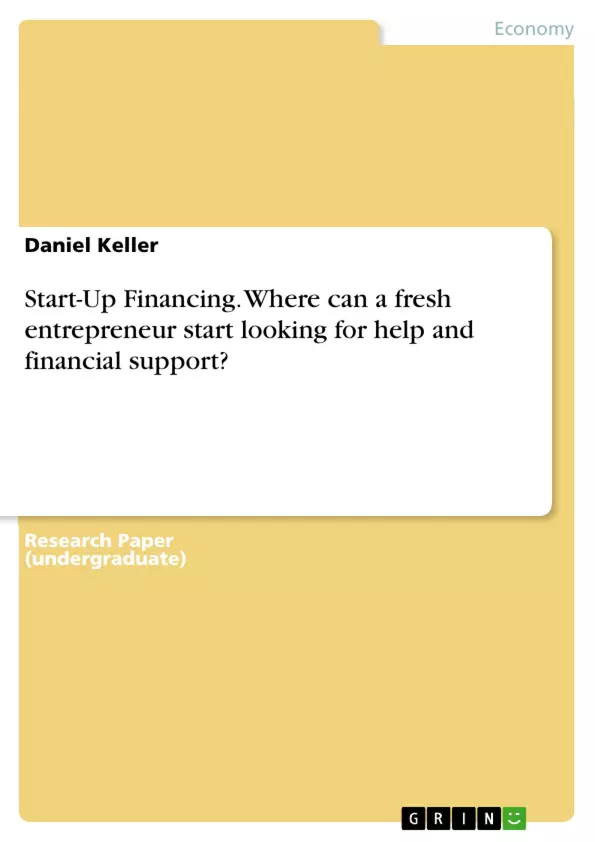To have a great idea for a Start-up is a very good predisposition for a successful business. Despite this amazing thought, unfortunately a lot of Start-ups fail at the beginning.
According to the statistics 34% of entrepreneurs are 20-29 years old and 40% are between 30-39 years old once they start their first business. Most of the people in this age are already well-educated and they do not have many savings. It makes them look for alternatives, which could support the first critical years of their Start-up. At the beginning no one wants to invest in an unknown business, which leaves them with the idea of borrowing money elsewhere. As a matter of fact, no one wants to take a disadvantageous loan, so young entrepreneurs usually ask their family and friends for help, but by taking this kind of money, they are putting the good friendships and relationships at stake. So what are the options? Where can a fresh entrepreneur start looking for help and financial support?
The answer should be clearer after reading this paper. The goal we are trying to reach, is to give a better overview of the options of financing, the advantages and disadvantages of different methods and show it on real life examples. One of the most important thing is to be well informed about the possibilities which are available, so it may come to the realization of the original idea and building of a successful Start-up.
In order to give a better insight on this topic, we will also choose existing Start-ups and analyse what methods they have used, how they were implemented and what they had to give in return. We will pick not only from the successful ones, but also from the less fortunate businesses as it’s important to understand the know-how of winners just as important as to know the mistakes of others.
Inhaltsverzeichnis (Table of Contents)
- INTRODUCTION.
- START-UP
- START-UP PHASES.
- Concept/Seed Phase
- Start-up phase
- Emerging-Growth-Phase.
- Expansion-Phase.
- FINANCING METHODS.....
- DEEPER INSIGHT IN CHOSEN METHODS.
- CROWDFUNDING......
- Types of Crowdfunding...........
- Advantages and disadvantages of Crowdfunding...........
- Tips to Crowdfund the Start-up
- BOOTSTRAPPING
- Advantages and Disadvantages of bootstrapping.
- Tips to bootstrap the start-up
- CONCEPT OF A LOAN BY THE "VR BANK ROSENHEIM CHIEMSEE"
- ERP FOUNDER LOAN - STARTING MONEY
- THE BUSINESS PLAN
- THE EXECUTIVE SUMMARY..
- COMPANY DESCRIPTION
- MARKET ANALYSIS.......
- ORGANIZATION AND MANAGEMENT
- SERVICE OR PRODUCT LINE
- MARKETING AND SALES.
- FUNDING REQUEST..
- FINANCIAL PROJECTIONS
- APPENDIX
- SUCCESSFUL START-UPS
- DELIVERY HERO
- SPOTIFY
- START-UP FIASCOS
- KNOWN REASONS FOR FAILURE.
- AKA-AKI GMBH
- KAZZONG
- CONCLUSION
- REFERENCES.
Zielsetzung und Themenschwerpunkte (Objectives and Key Themes)
This paper aims to provide a comprehensive overview of startup financing methods, highlighting the advantages and disadvantages of different approaches. It further explores real-life examples of successful and less successful startups, emphasizing the importance of understanding both winning strategies and common mistakes.
- The different phases of a startup's development.
- Various financing methods available to startups.
- Advantages and disadvantages of specific financing methods, including crowdfunding and bootstrapping.
- The role of the business plan in securing funding.
- Case studies of successful and unsuccessful startups.
Zusammenfassung der Kapitel (Chapter Summaries)
The paper begins by defining what constitutes a startup and outlines the typical phases a startup undergoes, from the initial concept phase to expansion. It then delves into various financing methods, offering detailed analysis of crowdfunding and bootstrapping, including their advantages, disadvantages, and practical tips for implementation. The text also discusses the concept of a loan from VR Bank Rosenheim Chiemsee and the importance of a well-structured business plan.
The paper further explores successful startups like Delivery Hero and Spotify, analyzing their funding strategies and growth trajectories. Additionally, it examines the reasons behind startup failures, using specific examples like AKA-AKI GMBH and Kazzong to illustrate common pitfalls.
Schlüsselwörter (Keywords)
The paper focuses on the key concepts of startup financing, encompassing various methods like crowdfunding and bootstrapping, the development of business plans, and the analysis of successful and unsuccessful startup case studies. It also touches upon the importance of understanding the different phases of a startup's lifecycle, with particular attention to the challenges faced in the early stages.
- Quote paper
- Daniel Keller (Author), 2016, Start-Up Financing. Where can a fresh entrepreneur start looking for help and financial support?, Munich, GRIN Verlag, https://www.grin.com/document/375501



